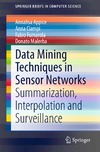Emerging real life applications, such as environmental compliance, ecological studies and meteorology, are characterized by real-time data acquisition through a number of (wireless) remote sensors. Operatively, remote sensors are installed across a spatially distributed network; they gather information along a number of attribute dimensions and periodically feed a central server with the measured data. The server is required to monitor these data, issue possible alarms or compute fast aggregates. As data analysis requests, which are submitted to a server, may concern both present and past data, the server is forced to store the entire stream. But, in the case of massive streams (large networks and/or frequent transmissions), the limited storage capacity of a server may impose to reduce the amount of data stored on the disk. One solution to address the storage limits is to compute summaries of the data as they arrive and use these summaries to interpolate the real data which are discarded instead. On any future demands of further analysis of the discarded data, the server pieces together the data from the summaries stored in database and processes them according to the requests.
This work introduces the multiple possibilities and facets of a recently defined spatio-temporal pattern, called trend cluster, and its applications to summarize, interpolate and identify anomalies in a sensor network. As an example application, the authors illustrate the application of trend cluster discovery to monitor the efficiency of photovoltaic power plants. The work closes with remarks on new possibilities for surveillance gained by recent developments of sensing technology, and with an outline of future challenges.
 |
|
О проекте
|
|
О проекте


